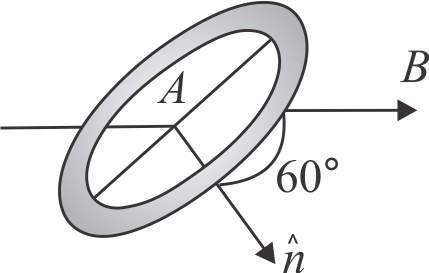358682
A coil of area \({A=0.5 m^{2}}\) is situated in a uniform magnetic field \({B=4.0 {~Wb} / {m}^{2}}\), and area vector makes an angle of \({60^{\circ}}\) with respect to the magnetic field, as shown in the figure. The value of the magnetic flux through the area \({A}\) would be equal to
358683 Consider a circular coil of wire carrying constant current \(I\), forming a magnetic dipole. The magnetic flux through an infinite plane that contains the circular coil and excluding the circular coil area is given by \(\phi_{i}\). The magnetic flux through the area of the circular coil area is given by \(\phi_{0}\). Which of the following option is correct?
358682
A coil of area \({A=0.5 m^{2}}\) is situated in a uniform magnetic field \({B=4.0 {~Wb} / {m}^{2}}\), and area vector makes an angle of \({60^{\circ}}\) with respect to the magnetic field, as shown in the figure. The value of the magnetic flux through the area \({A}\) would be equal to
358683 Consider a circular coil of wire carrying constant current \(I\), forming a magnetic dipole. The magnetic flux through an infinite plane that contains the circular coil and excluding the circular coil area is given by \(\phi_{i}\). The magnetic flux through the area of the circular coil area is given by \(\phi_{0}\). Which of the following option is correct?
358682
A coil of area \({A=0.5 m^{2}}\) is situated in a uniform magnetic field \({B=4.0 {~Wb} / {m}^{2}}\), and area vector makes an angle of \({60^{\circ}}\) with respect to the magnetic field, as shown in the figure. The value of the magnetic flux through the area \({A}\) would be equal to
358683 Consider a circular coil of wire carrying constant current \(I\), forming a magnetic dipole. The magnetic flux through an infinite plane that contains the circular coil and excluding the circular coil area is given by \(\phi_{i}\). The magnetic flux through the area of the circular coil area is given by \(\phi_{0}\). Which of the following option is correct?
358682
A coil of area \({A=0.5 m^{2}}\) is situated in a uniform magnetic field \({B=4.0 {~Wb} / {m}^{2}}\), and area vector makes an angle of \({60^{\circ}}\) with respect to the magnetic field, as shown in the figure. The value of the magnetic flux through the area \({A}\) would be equal to
358683 Consider a circular coil of wire carrying constant current \(I\), forming a magnetic dipole. The magnetic flux through an infinite plane that contains the circular coil and excluding the circular coil area is given by \(\phi_{i}\). The magnetic flux through the area of the circular coil area is given by \(\phi_{0}\). Which of the following option is correct?
